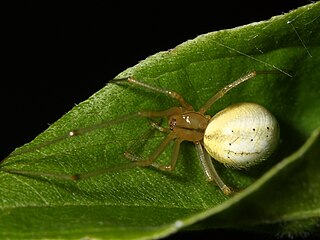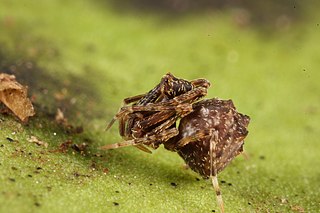
The family Dipluridae, known as curtain-web spiders are a group of spiders in the infraorder Mygalomorphae, that have two pairs of booklungs, and chelicerae (fangs) that move up and down in a stabbing motion. A number of genera, including that of the Sydney funnel-web spider (Atrax), used to be classified in this family but have now been moved to Hexathelidae.

The Mesothelae are a suborder of spiders that includes a single extant family, Liphistiidae, and a number of extinct families. This suborder is thought to form the sister group to all other living spiders, and to retain ancestral characters, such as a segmented abdomen with spinnerets in the middle and two pairs of book lungs. Members of Liphistiidae are medium to large spiders with eight eyes grouped on a tubercle. They are found only in China, Japan, and southeast Asia. The oldest known Mesothelae spiders are known from the Carboniferous, over 300 million years ago.

The spider family Liphistiidae, recognized by Tamerlan Thorell in 1869, comprises 8 genera and about 100 species of medium-sized spiders from Southeast Asia, China, and Japan. They are among the most basal living spiders, belonging to the suborder Mesothelae. In Japan, the Kimura spider is well known.

Theridiidae, also known as the tangle-web spiders, cobweb spiders and comb-footed spiders, is a large family of araneomorph spiders first described by Carl Jakob Sundevall in 1833. This diverse, globally distributed family includes over 3,000 species in 124 genera, and is the most common arthropod found in human dwellings throughout the world.

Linyphiidae, spiders commonly known as sheet weavers, or money spiders is a family of very small spiders comprising 4706 described species in 620 genera worldwide. This makes Linyphiidae the second largest family of spiders after the Salticidae. The family is poorly understood due to their small body size and wide distribution; new genera and species are still being discovered throughout the world. The newest such genus is Himalafurca from Nepal, formally described in April 2021 by Tanasevitch. Since it is so difficult to identify such tiny spiders, there are regular changes in taxonomy as species are combined or divided.

Scaffold web spiders or cave cobweb spiders (Nesticidae) are a family of araneomorph spiders closely allied with tangle-web spiders (Theridiidae). Like the Theridiidae, these spiders have a comb of serrated bristles on the hind tarsi that are used to pull silk bands from the spinnerets. Nesticidae contains 16 genera and about 300 species, many of which are associated with caves or overhangs. The genus Nesticus is the type for the family and is found throughout the world. The related Eidmannella has speciated considerably in Texas caves and includes some extremely localized species that are considered threatened. One species, Eidmannella pallida, is found in caves and under overhangs, but also in agricultural fields and other habitats away from such restricted areas. The genus Carpathonesticus is found in central Eurasia.

Dictynidae is a family of cribellate, hackled band-producing spiders first described by Octavius Pickard-Cambridge in 1871. Most build irregular webs on or near the ground, creating a tangle of silken fibers among several branches or stems of one plant.

Theridiosomatidae, commonly known as Ray Spiders, are a family of Arachnid first described by Eugène Simon in 1881. The family includes 137 species divided between 20 genus. They are most recognizable for their construction of cone-shaped webs.

Araneida is a subgroup of Tetrapulmonata. It was originally defined by Jörg Wunderlich in 2015 as a subgroup of Araneae, including all true spiders, with Wunderlich also including Uraraneida within Araneae. Araneida was redefined by Wunderlich in 2019 to include all modern spiders (Araneae), as well as Chimerarachnida, but excluding Uraraneida. Chimerarachnida and Araneae both possess spinnerets, which are absent in Uraraneida. Uraraneida and Araneida are grouped together in the clade Serikodiastida.

Tetrablemmidae, sometimes called armored spiders, is a family of tropical araneomorph spiders first described by Octavius Pickard-Cambridge in 1873. It contains 126 described species in 29 genera from southeast Asia, with a few that occur in Africa and Central and South America. Pacullidae was incorporated into this family in 1981, but was later restored as a separate family in a 2016 phylogenetic study.
Synaphridae is a family of spiders with thirteen described species in three genera. It was first described as a subfamily of Anapidae, but it has since been raised to family status.

Archaeidae, also known as assassin spiders and pelican spiders, is a spider family with about ninety described species in five genera. It contains small spiders, ranging from 2 to 8 millimetres long, that prey exclusively on other spiders. They are unusual in that they have "necks", ranging from long and slender to short and fat. The name "pelican spider" refers to these elongated jaws and necks used to catch their prey. Living species of Archaeidae occur in South Africa, Madagascar and Australia, with the sister family Mecysmaucheniidae occurring in southern South America and New Zealand.

Lasaeola is a genus of comb-footed spiders that was first described by Eugène Louis Simon in 1881. The type species was described under the name Pachydactylus pronus, but was renamed Lasaeola prona when it was discovered that the name "Pachydactylus" was preoccupied. Both this genus and Deliana were removed from the synonymy of Dipoena in 1988, but many of these species require more study before their placement is certain.

Agyneta is a genus of dwarf spiders that was first described by J. E. Hull in 1911.
Macarophaeus is a genus of European ground spiders that was first described by J. Wunderlich in 2011. As of May 2019 it contains only three species: M. cultior, M. insignis, and M. varius.
Canariphantes is a genus of dwarf spiders that was first described by J. Wunderlich in 1992. It might be a junior synonym of Lepthyphantes.

Ohlertidion is a genus of comb-footed spiders that was first described by J. Wunderlich in 2008. As of September 2019 it contains three species with a holarctic distribution, including Greenland: O. lundbecki, O. ohlerti, and O. thaleri. A 2019 genetic study proposed to synonymize this genus with Heterotheridion; however, the evidence was based predominantly on COI barcoding, which is a useful tool for separating species, but is less useful for determining higher taxa.

Physoglenidae is a family of araneomorph spiders first described by Alexander Petrunkevitch in 1928 as a subfamily of Pholcidae. It was later moved to Synotaxidae until a study in 2016 showed that they formed a distinct clade.

Psilodercidae is a family of spiders first described as a subfamily of Ochyroceratidae by Machado in 1951 and raised to family rank by J. Wunderlich in 2008. These spiders can be distinguished by the "segestriid positioning" of their six eyes, the absence of leg bristles, strong apical bristles on the cymbium, and several pairs of spermathecae in females.

Lagonomegopidae is an extinct family of spiders known from the Cretaceous period. Members of the family are distinguished by a large pair of eyes, positioned on the anterolateral flanks of the carapace, with the rest of the eyes being small. They have generally been considered members of Palpimanoidea, but this has recently been questioned. Members of the family are known from the late Early Cretaceous (Albian) to near the end of the Late Cretaceous (Campanian) of Eurasia, North America and the Middle East, which was then attached to Africa as part of Gondwana. They are generally assumed to have been free living hunters as opposed to web builders.
















